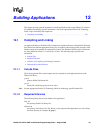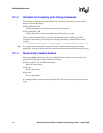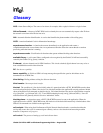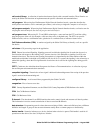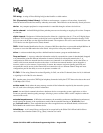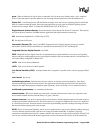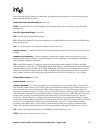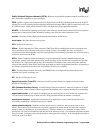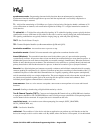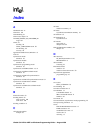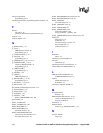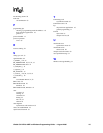
148 Global Call API for HMP on Windows Programming Guide — August 2006
Public Switched Telephone Network (PSTN): Refers to the worldwide telephone network accessible to all
those with either a telephone or access privileges.
QSIG: QSIG) is a protocol for Integrated Services Digital Network (ISDN) communications based on the Q.931
standard. It is used for signaling between digital private branch exchanges (PBXs). QSIG is employed in voice over
IP (VoIP) networks, virtual private networks (VPNs), and high-speed, multi-application networks.
R2 MFC: An international signaling system that is used in Europe, South America and the Far East to permit the
transmission of numerical and other information relating to the called and calling subscribers' lines.
receive: Accepting or taking digitized information transmitted by another device.
result value: Describes the reason for an event.
RFU: Reserved for future use.
SCbus: Signal Computing bus. Third generation TDM (Time Division Multiplexed) resource sharing bus that
allows information to be transmitted and received among resources over multiple data lines. A hardwired
connection between Switch Handlers on SCbus-based products for transmitting information over 1024 time slots to
all devices connected to the SCbus.
SCSA: Signal Computing System Architecture. An open-hardware and software standard architecture that
incorporates virtually every other standard in PC-based switching. SCSA describes the components and specifies
the interfaces for a signal processing system. SCSA describes all elements of the system architecture from the
electrical characteristics of the SCbus and SCxbus to the high level device programming interfaces. All signaling is
out of band. In addition, SCSA offers time slot bundling and allows for scalability.
SDP: Site Dependent Parameter file used by the PDKRT. Protocol configuration parameters that are user
modifible for a specific installation site.
SIT: See Special Information Tone.
Special Information Tone (SIT): Detection of an SIT sequence indicates an operator intercept or other
problem in completing a call.
SRL (Standard Runtime Library): A Intel® Dialogic library that contains C functions common to all Intel®
Dialogic devices, a data structure to support application development, and a common interface for event handling.
supervised transfer: A call transfer in which the person transferring the call stays on the line, announces the
call, and consults with the party to whom the call is being transferred before the transfer is completed.
synchronous function: Synchronous functions block an application or process until the required task is
successfully completed or a failed/error message is returned.
synchronization objects: Windows executive objects used to synchronize the execution of one or more
threads. These objects allow one thread to wait for the completion of another thread and enable the completed
thread to signal its completion to any waiting thread(s). Threads in Windows are scheduled according to their
priority level (31 levels are available) and run until one of the following occurs: 1) its maximum allocated execution
time is exceeded, 2) a higher priority thread marked as waiting becomes waiting or 3) the running thread decides to
wait for an event or an object.



